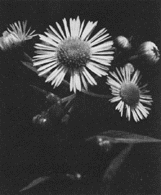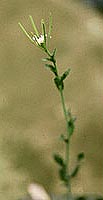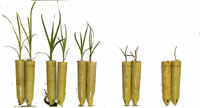Senior Lecturer

Contact
304 Jeffords Hall
- 802-656-9371
Areas of Expertise and/or Research
Evolutionary biology, ecological genetics
Education
- Ph.D. 1988, SUNY Stony Brook
Research and/or Creative Works
 I am interested in understanding patterns of natural selection and genetic variation in plant populations, and the way that genotype and environment combine to determine the distribution and abundance of plants in nature. I ask questions such as: How does the strength of natural selection vary within and between populations? What is the scale of environmental heterogeneity as experienced by individual genotypes? How do genotypes differ in the pattern of response to environmental variation? How does genetic variation affect broader patterns of distribution and abundance? To answer these questions I combine quantitative genetics with experimental demography to measure genetic variation under natural field conditions. Students in my lab work within the general field of ecological genetics, but their projects are independent of my specific research interests. Their projects have included studies of mating system evolution, phenotypic plasticity, and the effects of epistasis on adaptive evolution.
I am interested in understanding patterns of natural selection and genetic variation in plant populations, and the way that genotype and environment combine to determine the distribution and abundance of plants in nature. I ask questions such as: How does the strength of natural selection vary within and between populations? What is the scale of environmental heterogeneity as experienced by individual genotypes? How do genotypes differ in the pattern of response to environmental variation? How does genetic variation affect broader patterns of distribution and abundance? To answer these questions I combine quantitative genetics with experimental demography to measure genetic variation under natural field conditions. Students in my lab work within the general field of ecological genetics, but their projects are independent of my specific research interests. Their projects have included studies of mating system evolution, phenotypic plasticity, and the effects of epistasis on adaptive evolution.
Spatial and temporal variation in selection: Because interactions among plants are spatially local, the scale of environmental heterogeneity can have strong effects on evolutionary dynamics. Several field studies of Erigeron annuus showed that there is large variation in the relative fitness of genotypes within oldfield habitats and that the scale of variation in selection is extremely fine-grained. Temporal variation in selection is also large, which results in a fitness landscape with constantly shifting locations of peaks and valleys. Nevertheless, the presence of spatial or temporal variation in selection does not guarantee that it is an effective evolutionary force. Experimentally calibrated simulations showed that the scale of variation was too fine- grained to be a powerful force maintaining genetic variation in the population and instead selects for generalist genotypes.
 Genetics of niche evolution: I am currently examining the genetics of plant response to resource gradients and how genetic variation may affect the distribution and abundance of species. Using Arabidopsis thaliana as a model system, we have measured genetic variation in fitness over nutrient and light gradients and we are mapping the underlying quantitative trait loci that affect the shape of those 'fitness functions'. Among other things, that work is testing whether loci that increase the breadth of the fitness function also decrease fitness in the optimum environment. If those tradeoffs are not due the pleiotropic effects of individual alleles, then it may be possible to increase niche breadth with no detrimental effect on maximum fitness.
Genetics of niche evolution: I am currently examining the genetics of plant response to resource gradients and how genetic variation may affect the distribution and abundance of species. Using Arabidopsis thaliana as a model system, we have measured genetic variation in fitness over nutrient and light gradients and we are mapping the underlying quantitative trait loci that affect the shape of those 'fitness functions'. Among other things, that work is testing whether loci that increase the breadth of the fitness function also decrease fitness in the optimum environment. If those tradeoffs are not due the pleiotropic effects of individual alleles, then it may be possible to increase niche breadth with no detrimental effect on maximum fitness.
Ecological range expansion in cattails: A second area of current research uses two species of common cattail to study the genetic basis of contrasting species distributions. Cattails represent an unusually well-studied system where the environmental controls on distribution are understood and can be easily manipulated. Our recent ability to identify regions of the genome that cause differences in performance across environments now allows us to ask fundamental questions about the limits of ecological range expansion. F2 progeny from a cross between the two species are being grown along environmental gradients that are known to control the ecological range of cattails. Tests for the linkage of genetic markers to variation in drought tolerance, flooding tolerance and salinity tolerance will identify gene regions that control the ecological distribution of cattails. More generally, by looking at the effects of those QTL over the resource gradients, we can test whether the current distribution limits are maintained by tradeoffs or by conditional expression of deleterious alleles.
F2 progeny from a cross between the two species are being grown along environmental gradients that are known to control the ecological range of cattails. Tests for the linkage of genetic markers to variation in drought tolerance, flooding tolerance and salinity tolerance will identify gene regions that control the ecological distribution of cattails. More generally, by looking at the effects of those QTL over the resource gradients, we can test whether the current distribution limits are maintained by tradeoffs or by conditional expression of deleterious alleles.
Publications
Fishman, L. and D.A. Stratton. (2004). The genetics of floral divergence and postzygotic barriers between outcrossing and selfing populations of Arenaria uniflora (Caryophyllaceae). Evolution 58:296-307.
White, P.S., S. Wilds, and D.A. Stratton. (2001). The distribution of heath balds in the Great Smoky Mountains. Journal of Vegetation Science 12:453-466.
Stratton, D. A. (1998). Reaction norm functions and QTL-environment interactions for flowering time in Arabidopsis thaliana. Heredity 81:144-155.
Stratton, D. A. and C. C. Bennington. (1998). Spatial and temporal variation in selection are too fine-grained to maintain genetic variation in Erigeron annuus. Evolution 52:678-691.
Stratton, D. A. and C. C. Bennington. (1996). Measuring spatial variation in fitness of Arabidopsis thaliana using randomly sown seeds. Journal of Evolutionary Biology 9:215-228.
Stratton, D. A. (1995). Spatial scale of variation in fitness of Erigeron annuus. American Naturalist 146:608-624.
Stratton, D. A. (1992). Life cycle components of selection in Erigeron annuus I. Phenotypic selection. Evolution 46:92-106.
Stratton, D. A. (1992). Life cycle components of selection in Erigeron annuus II. Genetic variation. Evolution 46:107-120.
Courses Taught
Honors Colloquium (AGRI 196); Ecology and Evolution (BCOR 102); Genetics (BCOR 101)
